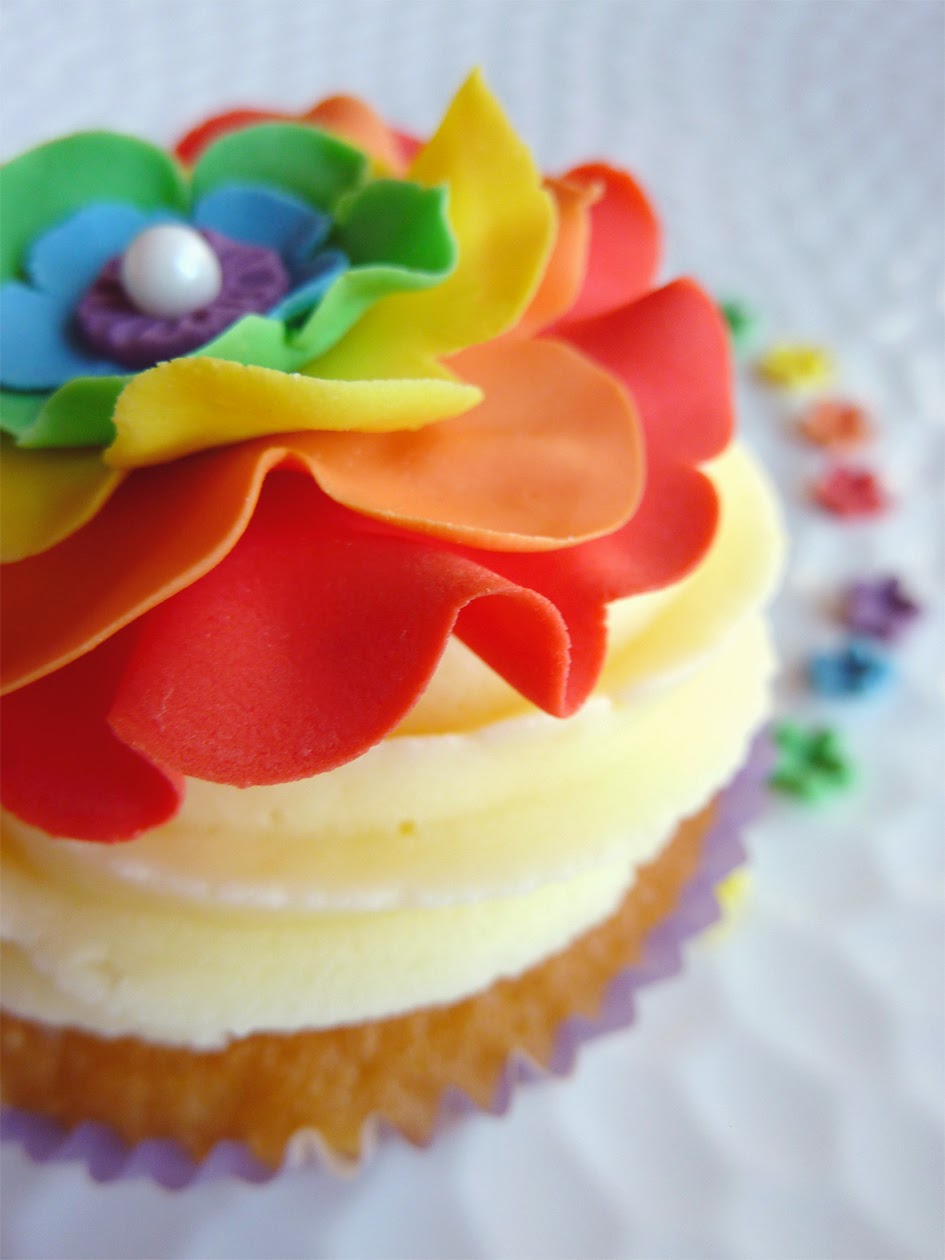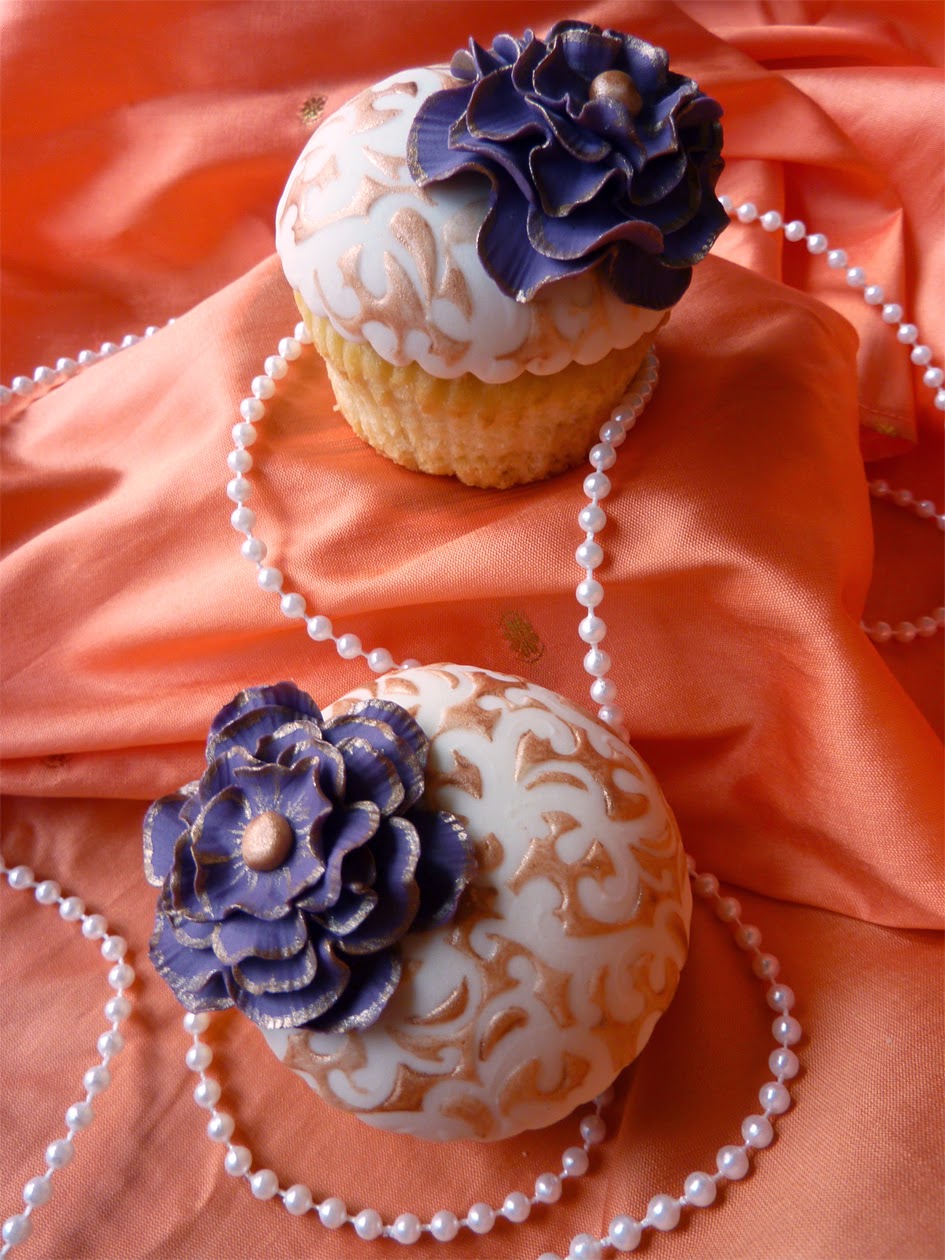I love traveling and all the new sights, sounds and experiences it brings. But I've come to realise that travel has something more to offer: design ideas! So here's what a recent trip to Kerala has led to:

The idea for this set took root in Kerala itself, while I worked on our Onam pookalam. I started thinking of how a pookalam would be such a great thing to cookie-fy: just let your imagination loose with the designs of your choice! Then I considered other Kerala icons. Coconut trees were a given, because I have a cutter :D I didn't want to go the Kathakali route as honestly, I find the green face-black eye combo a bit freaky! Kris really wanted me to make elephant cookies, especially because of her nettipattam fascination, but without a cutter I found it a bit tricky to pull off. Then it struck me, simple and sweet - a kasavu print!
This Onam was my first time wearing a kasavu sari, beautifully draped thanks to my dear sister-in-law's expertise. The basic kasavu look is a golden border (of varying thickness) against white or cream. That is what I've tried to replicate in this cookie, and it's incredibly simple to do. Just cover the cookie in white royal icing and let it dry completely, for about 6-8 hours. Then mix some edible gold dust with clear vanilla extract / lemon juice to get a paint consistency and use a square brush going from one side to the next. Then of course, you can get more adventurous, like the kasavu saris I saw when I went shopping this time, with intricate embroidery and even some north-south fusion happening!
Next, I got started on the coconut trees.The trickiest bit of course, is the leaves. You could pipe them on, and I did give that a shot. Not fun. Much easier, and also way more fun, is to do them using a technique called wet on wet icing, where you fill in a base colour and then immediately pipe other colours on top of it, so that the new icing sinks into the base icing. You can then manipulate the colours to create swirls or shading effects.
You'll need royal icing in:
- Brown, filling consistency
- Dark green, piping and filling consistencies
- Light green, filling consistency
- Yellow, filling consistency
- Orange, filling consistency (only if you want to add coconuts)
1. I started off filling in the trunks with brown icing and letting them dry, at least 2-4 hours. Then, working with one cookie at a time, outline the leaf part with dark green piping icing and fill in with the fill consistency.
2. Immediately pipe a line of light green icing starting from the center and moving out to the tip of each leaf.
3. Follow with the yellow on top of the light green, and you can be a bit random with this, as the yellow doesn't need to be uniform; I just found that the odd bit of yellow here and there made it pop a bit.
4. Now the fun part! Use a toothpick, or other pointy tool and drag it through the icing in sideways swirls from the top of the line to the tip of the leaf. Clean the pick on kitchen paper and then drag it through the center of the leaf from top to bottom.
5. Finish all the leaves in the same way. You can go back and do some more swirls if the icing needs to be spread better. Allow to dry till set 6-8 hours.
6. Add coconuts with the orange icing. If you want to be more realistic, use orange piping icing to add those funny bead-like thingies, like in the last tree. I asked hubby if he knew what they were, and apparently that's like the flower of the tree, can you believe it?! Use a brown food marker, or food paint and add random lines across the trunks if you want.
And now, best for last, my pookalam cookies!
I used some of my smaller flower and circle cutters to trace the outlines on the cookies with food markers, and freehanded the details in. Normally, cookies are decorated as described above for the trees: outline with a thicker icing and fill in with a looser one to get a smooth finish. But since a real pookalam is made with flower petals, it has a textured look. The easiest way of recreating that effect I felt was to use one thick icing to fill each section. Give it about 5 minutes to set, and then using a fondant tool (pictured) or a toothpick, start poking at the icing and disturb the surface to get that texture. It's important to use thick icing and give it those few minutes to begin to harden, as looser icing will just merge back and won't retain the texture. Then just leave it 4-6 hours to set completely.
Here's my complete set of pookalam cookies. I stuck to colours that are typically used and the designs can be anything you like. This is the sort of decorating I enjoy the most, where you can play around with several colours and patterns.
So if you love decorating as well, keep those eyes peeled the next time you take a trip; along with souvenirs, you just might find some brilliant inspiration too!

The idea for this set took root in Kerala itself, while I worked on our Onam pookalam. I started thinking of how a pookalam would be such a great thing to cookie-fy: just let your imagination loose with the designs of your choice! Then I considered other Kerala icons. Coconut trees were a given, because I have a cutter :D I didn't want to go the Kathakali route as honestly, I find the green face-black eye combo a bit freaky! Kris really wanted me to make elephant cookies, especially because of her nettipattam fascination, but without a cutter I found it a bit tricky to pull off. Then it struck me, simple and sweet - a kasavu print!
This Onam was my first time wearing a kasavu sari, beautifully draped thanks to my dear sister-in-law's expertise. The basic kasavu look is a golden border (of varying thickness) against white or cream. That is what I've tried to replicate in this cookie, and it's incredibly simple to do. Just cover the cookie in white royal icing and let it dry completely, for about 6-8 hours. Then mix some edible gold dust with clear vanilla extract / lemon juice to get a paint consistency and use a square brush going from one side to the next. Then of course, you can get more adventurous, like the kasavu saris I saw when I went shopping this time, with intricate embroidery and even some north-south fusion happening!
Next, I got started on the coconut trees.The trickiest bit of course, is the leaves. You could pipe them on, and I did give that a shot. Not fun. Much easier, and also way more fun, is to do them using a technique called wet on wet icing, where you fill in a base colour and then immediately pipe other colours on top of it, so that the new icing sinks into the base icing. You can then manipulate the colours to create swirls or shading effects.
You'll need royal icing in:
- Brown, filling consistency
- Dark green, piping and filling consistencies
- Light green, filling consistency
- Yellow, filling consistency
- Orange, filling consistency (only if you want to add coconuts)
1. I started off filling in the trunks with brown icing and letting them dry, at least 2-4 hours. Then, working with one cookie at a time, outline the leaf part with dark green piping icing and fill in with the fill consistency.
2. Immediately pipe a line of light green icing starting from the center and moving out to the tip of each leaf.
3. Follow with the yellow on top of the light green, and you can be a bit random with this, as the yellow doesn't need to be uniform; I just found that the odd bit of yellow here and there made it pop a bit.
4. Now the fun part! Use a toothpick, or other pointy tool and drag it through the icing in sideways swirls from the top of the line to the tip of the leaf. Clean the pick on kitchen paper and then drag it through the center of the leaf from top to bottom.
5. Finish all the leaves in the same way. You can go back and do some more swirls if the icing needs to be spread better. Allow to dry till set 6-8 hours.
6. Add coconuts with the orange icing. If you want to be more realistic, use orange piping icing to add those funny bead-like thingies, like in the last tree. I asked hubby if he knew what they were, and apparently that's like the flower of the tree, can you believe it?! Use a brown food marker, or food paint and add random lines across the trunks if you want.
And now, best for last, my pookalam cookies!
I used some of my smaller flower and circle cutters to trace the outlines on the cookies with food markers, and freehanded the details in. Normally, cookies are decorated as described above for the trees: outline with a thicker icing and fill in with a looser one to get a smooth finish. But since a real pookalam is made with flower petals, it has a textured look. The easiest way of recreating that effect I felt was to use one thick icing to fill each section. Give it about 5 minutes to set, and then using a fondant tool (pictured) or a toothpick, start poking at the icing and disturb the surface to get that texture. It's important to use thick icing and give it those few minutes to begin to harden, as looser icing will just merge back and won't retain the texture. Then just leave it 4-6 hours to set completely.
Here's my complete set of pookalam cookies. I stuck to colours that are typically used and the designs can be anything you like. This is the sort of decorating I enjoy the most, where you can play around with several colours and patterns.
So if you love decorating as well, keep those eyes peeled the next time you take a trip; along with souvenirs, you just might find some brilliant inspiration too!































